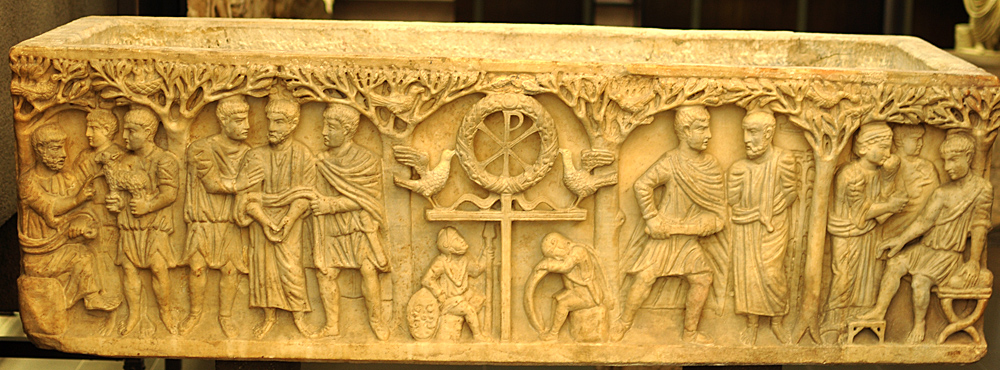Sarcophagus of the Passion, with Pilate's Wife

Rome, circa 350
Pio-Christian Museum, The Vatican
The panel on the far right is the earliest illustration I have seen of Matthew 27:19, "And as he [Pilate] was sitting in the place of judgment, his wife sent to him, saying: Have thou nothing to do with that just man; for I have suffered many things this day in a dream because of him." In the panel the "place of judgment" is signified by Pilate's "curule chair," on which Roman magistrates sat when hearing trials.
The central panel is nearly identical to the one in the
Sarcophagus of Domatilla, which is also from the middle of the 4th century. Two soldiers sit on stones beneath the horizontal bar of a cross. One looks up while the other nods in sleep. Birds on the bar symbolize resurrection and look up at a victory wreath enclosing the chi-rho ligature that abbreviates the name of Christ. (X and P are the first letters in Greek Christos.) The birds and guards refer to the Resurrection, the wreath to Christ's victory over death.
The first, second, and fourth panels each feature a man in a toga with a short beard. The man in the fourth panel is bald while the other two have hairlines low on their foreheads; but otherwise they seem identical, and no other man on the sarcophagus is pictured with a beard and toga, even Pilate. We can identify the man in the second panel as St. Peter because his arrest by soldiers in tunics closely resembles the same scene on other sarcophagi
(example). But is it Peter in the other two panels? And if so, what is happening to him?
In the first panel, the bearded man's hand gesture indicates that he is addressing the man before him, who has a lamb in his arms. Neither the Bible nor the apocrypha speak of anyone bringing St. Peter an actual lamb. but he was famously charged by Jesus to "feed my lambs" in John 21:15-16, so the lamb could be a symbolic doubling of the person to whom Peter is preaching (and thus "feeding" God's word). Metaphorical sheep and lambs appear often in the apocryphal accounts of Peter. When he converts a Roman senator named Marcellus in chapter 10 of the Acts of Peter, he prays to God, "receive thou Marcellus as one of thy lambs and suffer him no longer to go astray." And in one of the letters that scripture attributes to him he writes, "you were as sheep going astray; but you are now converted to the shepherd" (1 Peter 2:25). So yes, the bearded man could well be Peter.
The fourth panel is harder to explain. The odd design between Peter and the tree might represent the water that flowed from the rock when Peter was in prison, and thus the soldier with him could be one of the guards whom he baptized there. But why would the soldier be wielding a sword, and why is Peter bald only in this panel?
According to the museum label the sarcophagus was discovered during the excavations of the Duchess of Chablais at Tor Marancia, near Rome, in 1817-1821.
View this image in full resolution.
Read more about the Crucifixion, the Resurrection, the Trials of Jesus, and St. Peter.
Photographed at the museum by Richard Stracke, shared under Attribution-NonCommercial-ShareAlike license.